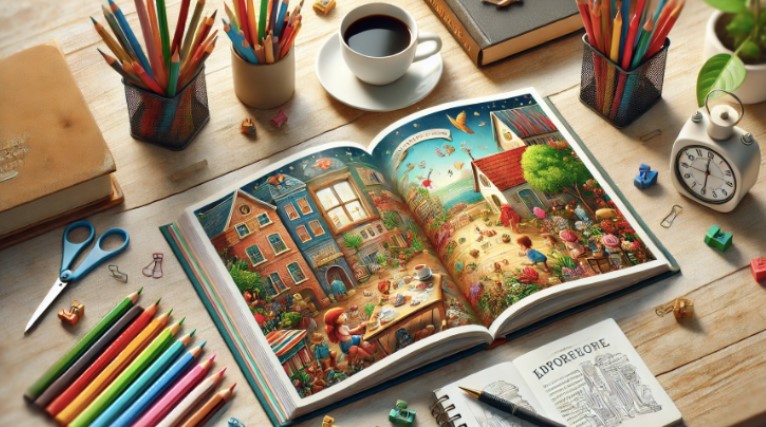Illustrations play a vital role in children’s books, bringing stories to life and captivating young readers’ imaginations. They help convey emotions, settings, and actions, making complex narratives easily understandable and enjoyable. Illustrations can turn a simple story into a magical experience, fostering a love for reading and storytelling in children.
This guide aims to provide a comprehensive overview for writers looking to understand the process of illustrating children’s books. Whether you plan to collaborate with an illustrator or decide to take on the task yourself, this guide will offer insights into key concepts and best practices.
We will explore the different types of children’s books, the role of an illustrator, the illustration process, and techniques for creating compelling characters and scenes. By the end of this guide, you’ll have a solid foundation for creating engaging and visually appealing children’s books that delight and inspire young readers.
This guide on illustrating children’s books provides a comprehensive overview for writers and illustrators, covering essential aspects from story development and inspiration to final artwork. Here’s what you’ll learn:
- Developing Your Story Idea: Crafting a strong story and balancing text with illustrations.
- The Role of the Illustrator: Responsibilities, collaboration, and successful partnerships.
- The Illustration Process: Steps from concept to final artwork, including techniques and materials.
- Illustration Styles and Techniques: Popular styles and how to choose the right one for your book.
- Creating Compelling Characters: Designing relatable and distinct characters.
- Bringing Your Story to Life: Techniques for illustrating scenes, using colors, and ensuring readability.
- Working with Freelance Illustrators: Finding illustrators and navigating the publishing process.
- This guide aims to inspire and equip you to create and illustrate your own children’s book, emphasizing the joy and impact of captivating illustrations.
Children’s Books
Children’s literature encompasses various types of books, each designed to cater to specific age groups and developmental stages. The three main types are picture books, chapter books, and board books, each with unique characteristics and illustration needs.
Picture books are designed for young children, typically aged 2 to 7. They feature large, colorful illustrations on every page, often telling the story as much as the text. These books usually contain 32 pages and are ideal for read-aloud sessions, helping children develop listening skills and early literacy.
Chapter books target children aged 7 to 10, bridging the gap between picture books and more advanced novels. They contain fewer illustrations, which are often black-and-white and scattered throughout the text. Illustrations in chapter books support comprehension, break up the text, and maintain the reader’s interest, especially for those transitioning to longer reading material.
Board books are sturdy, durable books for infants and toddlers aged 0 to 3. Made with thick cardboard pages, they are designed to withstand rough handling. The illustrations in board books are simple, bold, and colorful, capturing the attention of very young children and introducing them to the world of books.
Illustrations play a crucial role in all these types of children’s books. For young readers, pictures provide visual cues that aid in understanding and enjoying the story. They also stimulate imagination, enhance emotional engagement, and support the development of vocabulary and narrative skills. The target audience and age group significantly influence the style, complexity, and frequency of illustrations, ensuring that the book is appropriate and engaging for its intended readers.
Developing Your Story Idea
A strong story idea is the foundation of any successful children’s book. It captivates young readers, evokes emotions, and leaves a lasting impression. Your story should be engaging, relatable, and age-appropriate, with a clear beginning, middle, and end. A well-thought-out story idea sets the stage for compelling characters and vivid illustrations.
Collaboration with an illustrator is crucial if you’re not illustrating the book yourself. Communicate your vision clearly and be open to their creative input. A good illustrator will enhance your story, bringing depth and vibrancy to your narrative. If you choose to illustrate your own book, ensure that your artistic skills align with your storytelling to maintain a cohesive and compelling book.
Balancing text and illustrations is essential. In picture books, illustrations often carry as much weight as the text, if not more. The images should complement and enhance the story, not just repeat what the text says. Consider where illustrations can replace text, showing rather than telling. For chapter books, illustrations should break up the text and provide visual breaks that aid comprehension and maintain interest.
A harmonious balance between text and illustrations ensures that the book is engaging and accessible to young readers, fostering a love for reading and a deep connection to the story.
The Role of the Children’s Book Illustrator
The children’s book illustrator plays a pivotal role in bringing a story to life, transforming words into vibrant, engaging images that captivate young readers. Their responsibilities include interpreting the text, designing characters, and creating scenes that enhance the narrative and evoke the desired emotions.
Expectations for illustrators are high. They must ensure that their artwork is not only visually appealing but also appropriate for the target age group. Illustrators need to be adept at visual storytelling, using their illustrations to complement and expand upon the text, making the story more accessible and enjoyable for children.
Collaboration between authors and illustrators is essential for a cohesive and successful children’s book. Effective communication is key, with both parties sharing their visions and ideas openly. Authors provide the narrative framework, while illustrators contribute their artistic perspective, offering suggestions and insights that can enhance the story. This collaborative process often involves multiple rounds of feedback and revisions to ensure the illustrations align perfectly with the author’s intent.
Successful author-illustrator partnerships demonstrate the power of collaboration. For instance, the partnership between Roald Dahl and Quentin Blake resulted in iconic books like “Matilda” and “Charlie and the Chocolate Factory,” where Blake’s whimsical illustrations perfectly complemented Dahl’s imaginative stories. Another example is the collaboration between Maurice Sendak and Ruth Krauss on “A Hole Is to Dig,” showcasing how Sendak’s unique illustrations brought Krauss’s simple, yet profound text to life.
The Illustration Process
Creating illustrations for a children’s book involves a detailed and creative process that takes the story from initial concept to final artwork. Each step is crucial in ensuring the illustrations effectively complement and enhance the narrative.
Steps in the Illustration Process
1. Conceptualization: This initial stage involves understanding the story and its themes. The illustrator reads the manuscript, discusses ideas with the author, and starts brainstorming visual concepts.
2. Thumbnail Sketches: Small, rough sketches, known as thumbnails, are created to map out the entire book. These sketches help in planning the layout, pacing, and composition of each page. They provide a visual blueprint for the book, allowing the artist or illustrator to experiment with different ideas and arrangements.
3. Character Development: The next step is developing the main characters. Illustrators create various sketches to explore different appearances, expressions, and movements. The goal is to make the characters visually appealing and relatable to the target audience.
4. Scene Development: Alongside character development, illustrators design the key scenes in the book. This involves deciding on the settings, backgrounds, and the overall mood of each illustration. Detailed sketches are made to refine these elements.
5. Creating the Final Artwork: Once the thumbnails and sketches are approved, the illustrator begins working on the final artwork. This step involves creating detailed and polished illustrations. Depending on the style, this can be done using traditional media such as colored pencils, watercolors, or digital tools.
The illustration process is a blend of creativity and technical skill, requiring meticulous planning and execution. From initial concepts to final artwork, each step is essential in creating engaging and visually stunning illustrations that bring a children’s book to life.
Illustration Styles and Techniques
Children’s book illustrations come in a variety of styles, each bringing a unique flavor and emotional tone to the story. Some of the most popular styles of children’s illustration include:
1. Realistic: Detailed and lifelike, realistic illustrations help ground fantastical stories in reality, making them more relatable.
2. Cartoon: Simplified and exaggerated, cartoon illustrations are playful and humorous, appealing to younger children.
3. Whimsical: Featuring imaginative and fantastical elements, whimsical illustrations add a sense of magic and wonder.
4. Minimalist: Using simple shapes and limited colors, minimalist illustrations focus on clarity and directness, ideal for very young readers.
5. Vintage: Evoking styles from past eras, vintage illustrations bring a nostalgic feel to stories, often using muted colors and intricate details.
6. Modern/Graphic: Bold lines, bright colors, and dynamic compositions characterize modern or graphic styles, making them visually striking and engaging.
Choosing the Right Style for Your Book
Selecting the appropriate illustration style is crucial in complementing and enhancing the story. Consider the following factors:
1. Target Audience: Young children might prefer bright, cartoonish styles, while older children may appreciate more detailed and realistic illustrations.
2. Story Tone: Whimsical and fantastical styles suit fairy tales and adventures, while realistic styles work well for more serious or educational stories.
3. Theme and Setting: The theme and setting of the story can guide the style choice. For instance, a historical story might benefit from a vintage style, while a futuristic tale might look best with a modern/graphic approach.
4. Author’s Vision: The author’s personal vision and the message they want to convey play a significant role in style selection. Collaboration with the illustrator ensures this vision is realized.
Examples of Different Styles and Their Impact on Storytelling
Realistic: In “The Polar Express” by Chris Van Allsburg, the realistic illustrations enhance the magical realism of the story, making the fantastical elements feel believable and immersive.
Cartoon: Dr. Seuss’s books, like “The Cat in the Hat,” use cartoonish illustrations to create a fun and engaging experience, perfectly matching the playful and rhythmic text.
Whimsical: “Where the Wild Things Are” by Maurice Sendak features whimsical illustrations that bring the imaginative world of wild creatures to life, enhancing the dreamlike quality of the narrative.
Minimalist: “Goodnight Moon” by Margaret Wise Brown, illustrated by Clement Hurd, uses a minimalist style to create a calm and soothing bedtime story, focusing on simple shapes and gentle colors.
Vintage: “Madeline” by Ludwig Bemelmans uses a vintage style with detailed line work and a limited color palette to evoke a timeless, classic feel.
Choosing the right illustration style is key to enriching the storytelling experience. By considering the target audience, story tone, theme, and the author’s vision, illustrators can create captivating visuals that not only complement but elevate the narrative, making the book memorable and engaging for young readers.
Creating Compelling Characters
Start by designing the main characters, focusing on their unique traits, personalities, and roles in the story. Think about how these characters will interact with each other and the world around them. Supporting characters should also be thoughtfully designed to complement the main characters and add depth to the narrative.
Ensuring Characters Are Relatable and Engaging
Characters should be relatable and engaging to capture the imagination of young readers. This can be achieved by giving them expressive faces, distinctive body language, and clothing that reflects their personality or role. Consider what qualities will resonate with the target audience, such as bravery, kindness, or curiosity. Incorporate these traits visually to create an immediate connection with readers.
Tips for Making Characters Visually Distinct
1. Unique Features: Give each character distinct features, such as different hairstyles, clothing styles, or accessories. This helps children easily differentiate and remember them.
2. Expressive Faces: Use a range of facial expressions to convey emotions and reactions, making characters more dynamic and engaging.
3. Color Schemes: Assign specific color schemes to each character to reinforce their identities and roles within the story.
4. Silhouettes: Ensure that characters have distinct silhouettes, which makes them recognizable even in simple or far-away depictions.
5. Consistent Details: Maintain consistency in character design throughout the book. Small, consistent details like freckles, glasses, or unique markings help reinforce the character’s identity.
By thoughtfully designing main and supporting characters, ensuring they are relatable, and making them visually distinct, illustrators can create compelling characters that capture the hearts and minds of young readers. These characters become the anchors of the story, making it memorable and engaging.
Bringing Your Story to Life
Start by understanding the mood and tone of each scene—whether it’s a calm, bedtime moment or an exciting adventure. Use dynamic compositions to create movement and energy in action-packed scenes, while more balanced, symmetrical compositions can convey calm and stability in quieter moments. Play with perspectives, such as bird’s-eye views for expansive landscapes or close-ups for intimate interactions, to add depth and interest.
Using Bright Colors and Engaging Compositions
Bright colors are particularly effective in capturing the attention of young readers and making the illustrations lively and appealing. Use a vibrant palette to highlight key elements and convey emotions. For instance, warm colors like red and yellow can evoke excitement and happiness, while cool colors like blue and green can create a sense of calm or mystery.
Engaging compositions are crucial for maintaining a child’s interest. Incorporate elements that guide the reader’s eye across the page, such as leading lines, focal points, and varying scales. Overlapping elements can create a sense of depth, while white space can help balance the composition and make the illustrations less overwhelming.
Making Illustrations Easily Readable and Enjoyable for Children
Ensuring that illustrations are easily readable and enjoyable is key to a successful children’s book. Use clear and simple shapes, avoiding overly intricate details that might confuse young readers. Contrast is important—ensure there’s enough difference between the background and the main elements so that characters and actions stand out clearly.
Incorporate interactive elements, like hidden details or repeating patterns, to engage children and encourage them to spend more time with each page. Thoughtful use of text placement is also important; make sure the illustrations leave enough space for the text to be legible without overlapping key visual elements.
By employing varied techniques for different scenes, using bright colors and engaging compositions, and ensuring readability, illustrators can create vibrant, captivating illustrations that bring stories to life and provide a delightful reading experience for children.
Working with Freelance Illustrators
Finding the right illustrator for your children’s book is crucial to bringing your story to life. Start by reviewing portfolios of illustrators whose work resonates with the style and tone of your book. Look for illustrators with experience in children’s books, as they will understand the nuances of engaging young readers. Websites like Behance, DeviantArt, and specialized platforms such as SCBWI (Society of Children’s Book Writers and Illustrators) can be great resources.
When choosing an illustrator, consider their previous work, style versatility, and ability to capture emotions and actions. Communicate your vision clearly and discuss how they plan to interpret your story. It’s also important to agree on timelines, deliverables, and budgets upfront.
Navigating the Freelance Illustrator Market
Working with freelance illustrators offers more flexibility and can often be more cost-effective. To navigate the freelance market, start by posting your project on platforms like Upwork, Fiverr, or Freelancer, where you can review proposals and portfolios from various artists.
Clearly outline your project requirements, budget, and timeline in your job posting. Once you find potential candidates, conduct interviews to discuss their approach, experience, and vision for your book. It’s important to establish a clear contract that outlines the scope of work, deadlines, payment terms, and ownership of the final artwork.
Finalizing Your Illustrations
Once your illustrations are complete, the final step is preparing them for publication. Ensure your artwork meets the technical specifications provided by the publisher, such as resolution, color mode, and file format. Typically, illustrations should be in high resolution (300 DPI) and in CMYK color mode for print.
Reviewing and Refining Illustrations
Before submitting your final artwork, review each illustration carefully. Look for any inconsistencies or errors that need correction. It’s helpful to get feedback from peers, mentors, or even children to ensure the illustrations are clear and engaging. Make necessary refinements to enhance the visual appeal and narrative coherence.
Ensuring Consistency and Quality Throughout the Book
Consistency is key in maintaining a cohesive look and feel throughout the book. Double-check that characters and settings remain consistent from page to page. Pay attention to the overall flow and pacing, ensuring that each illustration complements the text and maintains the reader’s interest. Use a style guide or reference sheet to keep track of colors, patterns, and other design elements.
By meticulously preparing, reviewing, and refining your illustrations, you ensure that the final artwork is of high quality and consistent throughout the book. This attention to detail will help create a polished and professional children’s book that captivates and delights young readers.
Final Thoughts
Illustrating children’s books involves understanding the different types of books, developing a strong story idea, collaborating effectively with illustrators, mastering the illustration process, and overcoming common challenges. By carefully finalizing your illustrations, you ensure a high-quality, engaging book.
Creating and illustrating your own children’s book is a rewarding endeavor that combines creativity and storytelling. Embrace the journey, experiment with various drawing styles, and enjoy the process.
Childrens book‘s book illustrations have a profound impact, bringing stories to life and sparking young imaginations. Your work can inspire and delight children, leaving a lasting impression on their lives.
Have you completed your manuscript for your children’s book and are ready to share it with the world? Spines is your gateway to the publishing realm, embodying the future of publishing. Our AI-powered platform is designed to revolutionize your publishing journey, offering comprehensive services such as detailed editing and proofreading, captivating cover creation, seamless distribution, and strategic marketing across various channels and platforms.
With Spines, your book is set to transcend the ordinary and make a significant impact in the new era of publishing. Sign up for free to start your self-publishing journey today.







